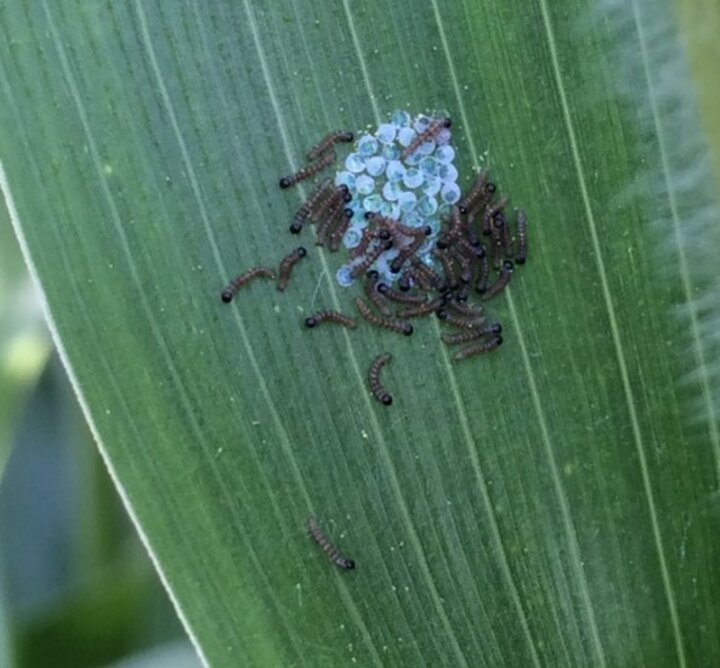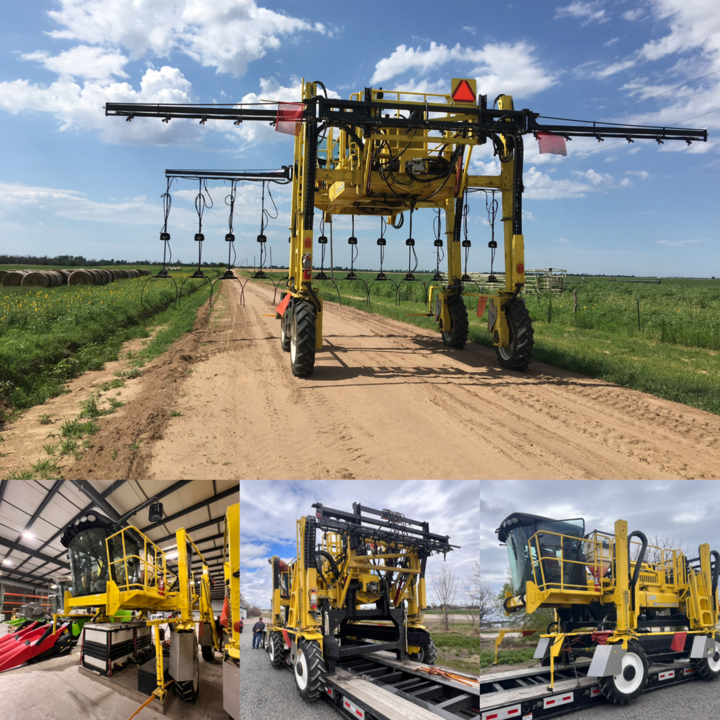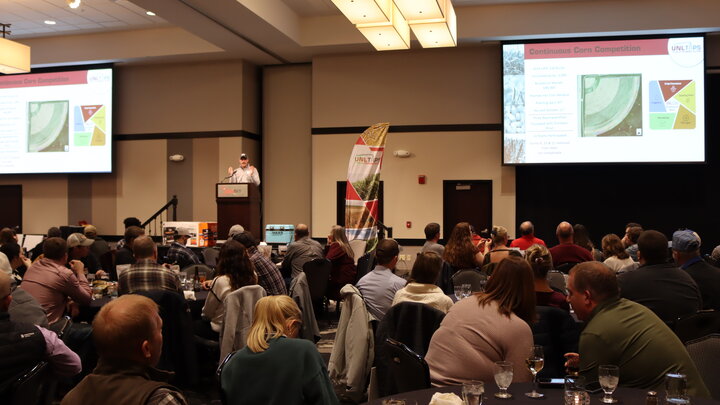
During the 2024 growing season, competitors in the sprinkler corn competition were given the opportunity to choose insecticide treatments targeting the western bean cutworm, a moth/caterpillar pest. This decision was based on scouting data gathered by Julie Peterson and her team on July 12, 15, and 19. The scouting report showed that a cumulative 4% of corn plants were infested with either eggs or newly hatched larvae (Figure 1).
Resources were also provided to competitors to help them decide if and when treatment for western bean cutworm is necessary. A quick decision was made by each farm to select whether an insecticide treatment should be made, and their choice of one of three insecticides:
Table 1. Insecticide choices and estimated costs.
Product Commercial Name | Active Ingredient | Rate (fl oz/ac) | Cost per acre (product) | Cost per acre (application) | Total cost per acre | Number of Farms Making this choice |
Untreated | - | - | $0 | $0 | $0 | 27 (71.1%) |
Vantacor | Chlorantraniliprole | 1.2 | $22.691 | $9.002 | $31.69 | 1 (2.6%) |
Elevest | Chlorantraniliprole + Bifenthrin | 4.8 | $16.88 | $9.00 | $25.88 | 1 (2.6%) |
Brigade | Bifenthrin | 5.0 | $7.43 | $9.00 | $16.43 | 9 (23.7%) |
1Costs of products are calculated from UNL’s 2024 Guide for Weed, Disease, and Insect Management in Nebraska; 2Cost of aerial application is estimated based on regional prices. These treatments will actually be applied using a high clearance sprayer (Figure 2).
Insecticides were applied at 15 gpa on Thursday, July 25 by Dr. Milos Zaric (Assistant Professor, Pesticide Application Technology Lab) with a high clearance sprayer with 10 ft wide boom (Figure 2). For each treated plot, the final 28 ft was left unsprayed as a control. Most competitors (71.1%) chose not to treat with an insecticide, whereas 9 farms (23.7%) chose Brigade, one (2.6%) chose Vantacor, and one (2.6%) chose Elevest (Table 1).

Figure 2. High clearance sprayer used for insecticide applications.
On August 22, 2024, the entomology research team collected and examined 10 corn ears each from the sprayed and unsprayed portions of representative plots to determine ear feeding injury to the crop (measured in square inches of feeding damage). Within each plot, the amount of damage to the sprayed ears was subtracted from the amount of damage to the unsprayed ears to calculate the average square inches of damage prevented by the insecticide application (Figure 3). Overall, feeding injury due to western bean cutworm was very low, as would be expected due to the scouting showing 4% infestation rate, which is just below the economic threshold. Shown in the orange bars in Figure 3, the farms that selected corn hybrids expressing the Vip3A Bt protein (trait packages such as AcreMax Leptra and Trecepta), no additional protection from caterpillar feeding was provided by spraying Brigade or Elevest (none chose to spray Vantacor). The Bt protein Vip3A provides good control of WBC without the need for additional insecticide spraying. Shown in the green bars in Figure 3, the farms that selected hybrids that did not express the Vip3A Bt protein (and therefore were vulnerable to WBC feeding) showed a minor amount of prevention of feeding damage, with Vantacor providing slightly more protection than Brigade (none chose to spray Elevest). For those competitors that chose not to spray an insecticide, the Vip3A Bt protein prevented approximately 0.04 in2 of feeding.

Using these ear feeding results to predict the impact on crop yield, the economic costs and benefits of each insect management choice was calculated and presented in Table 2 below. If no insect protection was used (non-Vip3A hybrid chosen and no insecticide sprayed), the feeding damage from western bean cutworm resulted in a loss of only 0.32 bu/ac (a loss of $1.28/ac). No matter the hybrid chosen or insecticide chosen, spraying with an insecticide did not result in an economic benefit. This supports the use of the 5-8% economic threshold for insecticide applications, since these fields had just 4% infestation in 2024. Based on crop prices in 2024, using the higher end of the economic threshold range (8%) would be most effective. Planting a corn hybrid with the Vip3A protein and not spraying any insecticide was the best option, resulting in the least amount of loss ($1.07/ac).
Table 2. Calculation of costs/benefits for each combination of insect management decisions.
Hybrid Chosen | Insecticide Chosen | % yield impact | bu/ac impact1 | $/acre impact2 | Cost of management3 | Total Cost/Benefit |
Non-Vip3A | None | -0.16% (loss) | -0.32 | -$1.28 | $0 | -$1.28 |
Non-Vip3A | Brigade | +0.05% (gain) | +0.10 | +$0.40 | $16.43 | -$16.03 |
Non-Vip3A | Elevest | Not selected by any farms | ||||
Non-Vip3A | Vantacor | +0.26% (gain) | +0.51 | +$2.04 | $31.69 | -$29.65 |
Vip3A | None | +0.12% (gain) | +0.23 | +$0.92 | $1.99 | -$1.07 |
Vip3A | Brigade | +0.12% (gain) | +0.23 | +$0.92 | $18.42 | -$17.50 |
Vip3A | Elevest | +0.12% (gain) | +0.23 | +$0.92 | $27.87 | -$26.95 |
Vip3A | Vantacor | Not selected by any farms | ||||
1Calculated assuming a 200 bu/ac yield. 2Using $4/bu sale price of corn. 3Calculated as the cost of the application and insecticide (if chosen) from Table 1, plus $1.99/ac cost of choosing a Vip3A hybrid (calculated from the average costs of hybrids chosen by TAPS participants).
